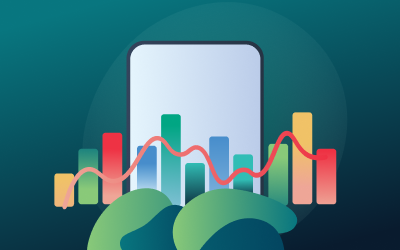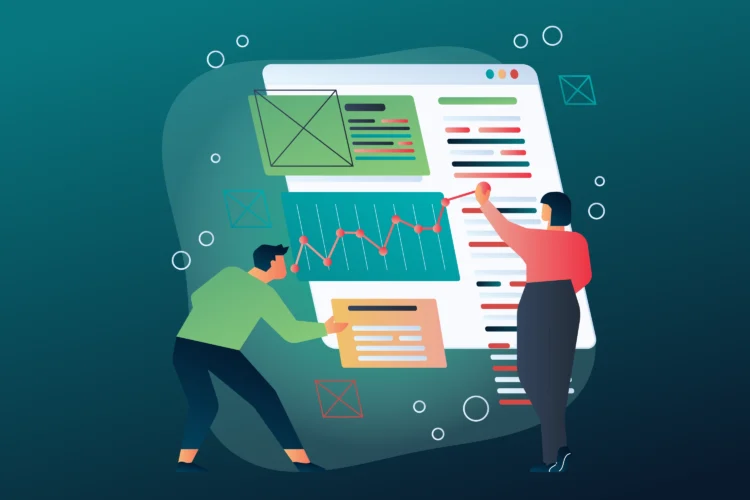
This is a guide for all the marketers and new SaaS or B2B Tech businesses who may feel a bit lost between endless graphs, buzzwords and lengthy explanations about marketing attribution. At the end of the day, your question is simple: how do I determine what is bringing me customers and money? We’re here to answer it, in the simplest way.
What is B2B marketing attribution and why does it matter?
Marketing attribution is the process of determining which marketing channels and courses of action are driving your conversions and sales. Although the definition sounds simple, it is anything but – marketing attribution requires careful observation of your customers’ behavior patterns, a couple of wild guesses, lots of experimentation and analysis, and in some cases even a bit of calculus.
While it may sound like a lot of hassle, marketing attribution should definitely be on the list of priorities for both budding and well-established B2B SaaS businesses. Sure, fidget spinner dropshippers really don’t have to ponder at night where their impulsive buyers are coming from, but the nature of B2B businesses requires you to be analytical and observant in your marketing approach.
Marketing attribution helps you understand your customers better, makes your marketing efforts more efficient, and in the end, ensures you have a solid return on your investment.
Now, let’s dive into it and see how marketing attribution works for B2B software products!
7 Types of Attribution Models – The Story of Alyson’s Journey
There are several ways SaaS businesses determine which marketing channels and tactics are driving their conversions and sales. While you may find that some authors mention even more attribution models or use different, niche-specific terms for them – we’re going to stick to the gist of it. Now let’s lay out the basics – your imaginary customer Alyson’s journey.
The Journey
For the purpose of this story, let’s imagine your company developed a software that helps businesses manage their projects. Your software service offers businesses the ability to organize their teams and tasks, track time and efforts, and invoice and bill work accordingly.
When it comes to SaaS business customers, you know you are not dealing with impulsive buyers. They want to explore your product and see if it fits before they commit to it. To buy your product, project manager Alyson would go through three distinctive phases:
- Awareness (paid ad and SEO/content marketing): In the beginning, Alyson may run into a paid ad for your software on Facebook. You are targeting her because she’s a project manager in an emerging startup. She may click on the ad, check out your website, and leave without taking any action. After a while, Alyson is searching for some cool project management hacks and she runs into your blog post about the topic. She reads the article, finds it informative and signs up for your newsletter. You got yourself a lead!
- Consideration (email and content marketing): After a couple of days, Alyson receives an email with a link to your website, leading to a particularly convincing case study for your software and CTA. After reading it, she signs up for a free trial of your product.
- Purchase (word-of-mouth and direct traffic): As Alyson’s free trial is nearing its end and she seems happy with your product, she googles reviews for your product. After seeing they’re overwhelmingly positive, she goes directly to your site and purchases an annual subscription to your software service!
User journey doesn’t really end here (read this guide for everything you need to know about the product adoption process), but for the purposes of gauging marketing attribution, we will stop at the purchase.
As you can see, with B2B marketing, things are rarely simple – conversion can last anywhere from one day to several months, and there are multiple touchpoints we haven’t even mentioned in this description.
They include affiliate links, paid ads on different social networks and Google, interactive marketing, etc. The possibilities are endless – but once you incorporate them into your marketing strategy, you have to know how they work individually and in synergy.
Now let’s see how that works.
1. Last Touch Attribution
This model credits the purchase to the last touchpoint between the customer and your business. In Alyson’s case, you’d attribute all the value to “direct traffic”, because after being assured that your product is great by positive reviews, Alyson went directly to your site and subscribed.
While this is the default attribution model in Google Analytics, even from this short description, you can see its flaws. Alyson would have never gone directly to your website had there not been other touchpoints – paid ads, SEO content, newsletter, well-crafted case study, and good reviews.
Should I use it?
Last-touch-attribution is a good choice for businesses whose user journey has fairly short consideration phases, such as retail. Verdict: as a B2B SaaS, skip it.
2. First Touch Attribution
This model credits the purchase to the first touchpoint between the customer and your business. In Alyson’s case, you’d attribute the value to the “paid ad”, because that’s how she found out about your software. Once again, you can easily see the flaw of this approach in the B2B software scenario – because Alyson’s click on the paid ad did not really produce the desired result.
Should I use it?
Much like the last-touch attribution model, this approach is good with businesses with short sales cycles and quick conversions. Verdict: skip it.
3. Last Non-Direct Click
This model seeks to dig a little deeper, but still maintain simplicity. Last non-direct click attribution credits the purchase to the last touchpoint between the customer and your business, excluding any direct traffic. In Alyson’s case, we would attribute all the value either to the positive reviews about your software or the conversion touchpoint – the case study. Since reviews are outside of your direct scope of marketing, we’d assign all the marketing value to the case study that converted Alyson. On the other hand, had Alyson run into paid review or a listicle with affiliate link leading to your website – you’d count that as the touchpoint.
Should I use it?
By removing direct traffic as proof of the customer’s awareness, this approach seeks to pinpoint the moment of conversion. However, it still ignores the synergy of all the elements of your marketing strategy – Alyson would have never gotten to your case study had she not previously seen paid ads, good blog content and interesting newsletter. Final verdict: skip it or use it to test touchpoints in your sales funnel. For example, if you notice that case studies excel at converting your customers, focusing on this attribution model can help you understand if some of these studies are doing better than others.
4. Linear Attribution
The linear attribution model divides credit across all marketing touchpoints. This means that each touchpoint Alyson went through (five of them), gets the same value. In her case she went through paid ad, SEO blog post, email, case study, and direct traffic.
Should I use it?
This model allows you to assess the big picture and streamline your marketing strategy. For B2B SaaS, this marketing attribution model is a good starting point, because these businesses have longer sales cycles. It assigns value to different marketing channels and their unique role in user journey. However, as time progresses and you seek to fine-tune your marketing strategy, you may find this attribution model obsolete. After all – the initial paid ad click didn’t make as much impression as the blog post – that was the moment Alyson showed interest in your product. Verdict: good starting point.
5. Time Decay Attribution
This marketing attribution splits credit across all the touchpoints – but it assigns greater value to the interactions that took place closer to the purchase. In Alyson’s case, the final, direct visit to the website gets the greatest credit, while paid ad gets the least credit.
Should I use it?
Time Decay Attribution is a great attribution model for B2B sales cycles, which tend to have stretched-out consideration stages and trials. This model is good at pinpointing channels that lead to conversions – in Alyson’s case, it is clear that with time her interest grew and that each follow-up touchpoint left a stronger impression on her. Final verdict: go with it!
6. Position-based Attribution
This model is also known as “U-shaped attribution” – it distributes credit across all the touchpoints, but assigns greatest value to the first and last interaction. In Alyson’s case, this means paid ad and direct traffic.
Should I use it?
This attribution model is also a good choice for SaaS products aimed at businesses, because it maintains the focus on the entire sales cycle, yet accentuates two important moments during the sales cycle – awareness and conversion.
Whether this approach is better than time decay attribution depends on the type of your software and sales cycle, but keep in mind that it can overlook an incredibly important stage in the B2B cycle – consideration.
7. Custom attribution models
Custom attribution model assigns value to each touchpoint in your sales cycle – but this value varies based on the touchpoint’s performance. In Alyson’s case, the greatest realistic value would be assigned to the intangible metric you didn’t directly control – positive reviews, traditionally called word-of-mouth. The greatest technical credit, however, goes to a great case study that converted her from interested user to trial customer.
Now why did we even include those positive reviews in this story, given that they are not a touchpoint you created? Because once you pinpoint that many of your conversions happen through word of mouth, you can add it as a measurable touchpoint by building affiliate links. And that is why good marketing attribution is important – because it allows you to tap into existing and potential channels that really sell your product.
Should I use it?
Ideally, yes – but custom attribution model requires marketing expertise, time, data, dedication, and lots of experimentation. While you should be looking to customize your marketing attribution, this model should be left for later phases of your SaaS business development.
What should I do next?
The first step towards marketing attribution for your B2B software product is setting up your website to track your sales cycle. You can do that using Google Analytics, which offers the following attribution models:
- Last Interaction (last touch)
- First Interaction (first touch)
- Last Non-Direct Click
- Last Google Ads Click (the first and only click to the Paid Search channel receives 100% of the credit for the sale).
- Linear
- Time Decay
- Position Based
As we previously mentioned, Google Analytics default setting is Last Touch Attribution. If you’re tech and marketing savvy, you can also create custom attribution models in Google Analytics.
Bonus tip
If you have Google Analytics 360, which is a part of Google Marketing Platform, you can try out Multi-Channel Funnels (MCF). It uses data from your Analytics account to create a custom attribution model based on what’s happening in your sales cycle.
Need help with setting up a perfect model for your business? Give us a call – we’ll have your conversions up, running and counting in no time!
Author
Jovan
Creating growth strategies for B2B SaaS products is one of my specialties. Over the last seven years, I've worked closely with a number of SaaS founders, VPs of marketing, and marketing managers to help them scale their businesses faster by applying growth marketing approaches. Goals. Grow and expand the agency to help even more B2B SaaS businesses.








